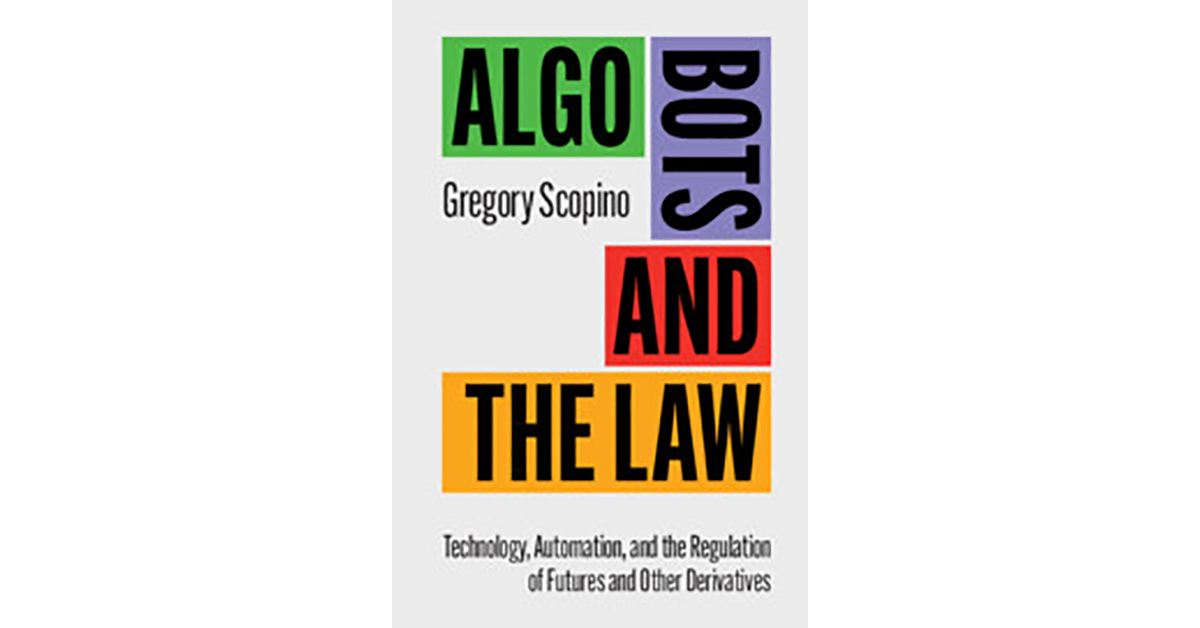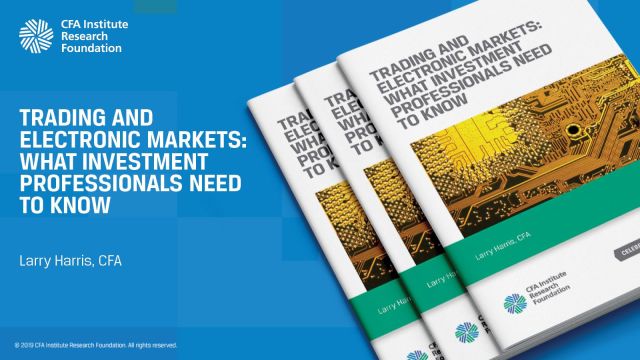[ad_1]
Algo Bots and the Law: Technology, Automation, and the Regulation of Futures and Other Derivatives. 2020. Gregory Scopino. Cambridge University Press.
Derivative trading technology has exploded in sophistication since the Great Financial Crisis, thanks to algorithms and electronic execution. The futures open outcry market is becoming a distant memory, but whether we have a regulatory environment that can effectively deal with an algo-driven execution world is not clear. Enhancements in technology are increasingly affecting trading behavior, yet the pandemic market crisis of March 2020 generated a wake-up call on issues of liquidity and market plumbing and the set of regulations that traders navigate to take and provide liquidity. In a crisis, the nexus of technology, rules, and regulations might fail investors who need liquidity to minimize their cost of dealing with an adverse market environment.
In Algo Bots and the Law, Gregory Scopino, a Georgetown University adjunct law professor and special counsel with the Market Participants Division of the Commodity Futures Trading Commission, attempts to make sense of this important intersection between regulation and execution technology.
Artificial intelligence (AI) has advanced automated trading
systems, or “algo bots,” to the point where programs can react more quickly
than any human trader and find relationships that the floor trader or market
maker can only imagine. Algo Bots and the
Law reviews and discusses the implications for market oversight of this
rapid electronic execution environment. For those not familiar with the history
and context of many issues of futures and derivative regulation, the first half
of this book is a good primer and addresses the key questions of what a futures
market is and how it should be regulated.
Futures regulation is distinct from securities regulation, having
different objectives and emphasis. Algo
Bots and the Law clearly explains a regulatory system that is filled with
arcane thinking that can be in conflict across regulatory agencies and global
jurisdictions. Derivative regulation of swaps markets is even newer, so rules
and case law are limited, somewhat murky, and contradictory. Regulatory clarity
is especially needed in the case of fintech developments, such as
cryptocurrencies.
Scopino’s descriptions serve as a foundation for more
complex algo trading and regulatory oversight topics addressed in the second
half of the book. Regulation today cannot be separated from past rulemaking and
precedents. Technology might advance markets yet be constrained by the legal
environment. Nonetheless, the regulatory environment needs to adapt to the
changing technology that facilitates transactions in our largest marketplaces.
Critical legal topics such as fraud, manipulation, “spoofing,” and market integrity in the context of advanced execution technology are described in detail. These issues have broad public interest when associated with “flash crashes” (i.e., extreme, short-term price declines resulting from disappearing liquidity). Traders perform price discovery and obtain liquidity information from market microstructure. The order book provides important information regarding the intentions of market agents, yet by posting and then canceling orders, an automated trading system can create the appearance of liquidity and market demand that do not exist. The fast addition and subtraction of orders can be viewed as both fraud and manipulation and can destroy the integrity of core market functions.
Seemingly simple issues can generate regulatory complexity.
Fraud and manipulation are based on traders’ intent, but can an algo bot that might
pull orders during a market decline, based on an AI reaction function or
feedback loop, have harmful legal intent? The author offers some answers and a
solution that involves regulating the algo bots as a market participant
category no different from floor traders. He also suggests a need for market
disruption funds and insurance-like solutions for flash crashes.
Algo Bots and the Law provides a deeply detailed journey through the history of futures and derivative markets regulation, from market definitions to how legal precedent influences current thinking on regulating electronic markets. However, finance professionals who are focused on market mechanics and how regulation affects their execution bottom line might be disappointed with the highly technical writing reminiscent of a law review article. Scopino does a fine job of making this work accessible via clear prose and good examples, yet he clearly has a legal audience in mind for his book. This is to the detriment of practitioners who want to understand how execution services could adapt to the regulatory environment and potentially enhance liquidity.
At more than 470 pages, this work could have been condensed
and focused on the future of regulation to create a more compelling story for a
wider audience. Algo Bots and the Law
would be more effective if it attempted to link the legal issues with the
growing research on market microstructure and focused on the intersection of
law and economics. Although Scopino touches on many important issues, asset
managers would likely prefer more vision on how regulation can shape the future
of execution and prevent market meltdowns.
Execution technology is an arms race, with those trying to create a market-making edge competing against those who are trying to minimize the cost of execution. The actions of one group that achieve a technological advantage invite a response from the other group. This conflict over different trading objectives drives trends in liquidity and transaction costs. The resulting benefits cannot be realized if market integrity is questioned or market meltdowns occur.
Markets are public goods, places where price discovery occurs through the conveyance of order information. Regulation therefore needs to look beyond competition and ensure the integrity of price information and adequate liquidity in a crisis. From my vantage point as a market practitioner and economist, Scopino’s legal focus, while well presented, misses an opportunity to advance views on market structure and to potentially influence readers and regulatory thinking in a direction that will anticipate and address possible execution problems in a world of fragile liquidity.
If you liked this post, don’t forget to subscribe to the Enterprising Investor.
All posts are the opinion of the author. As such, they should not be construed as investment advice, nor do the opinions expressed necessarily reflect the views of CFA Institute or the author’s employer.
Professional Learning for CFA Institute Members
CFA Institute members are empowered to self-determine and self-report professional learning (PL) credits earned, including content on Enterprising Investor. Members can record credits easily using their online PL tracker.
[ad_2]
Image and article originally from blogs.cfainstitute.org. Read the original article here.



